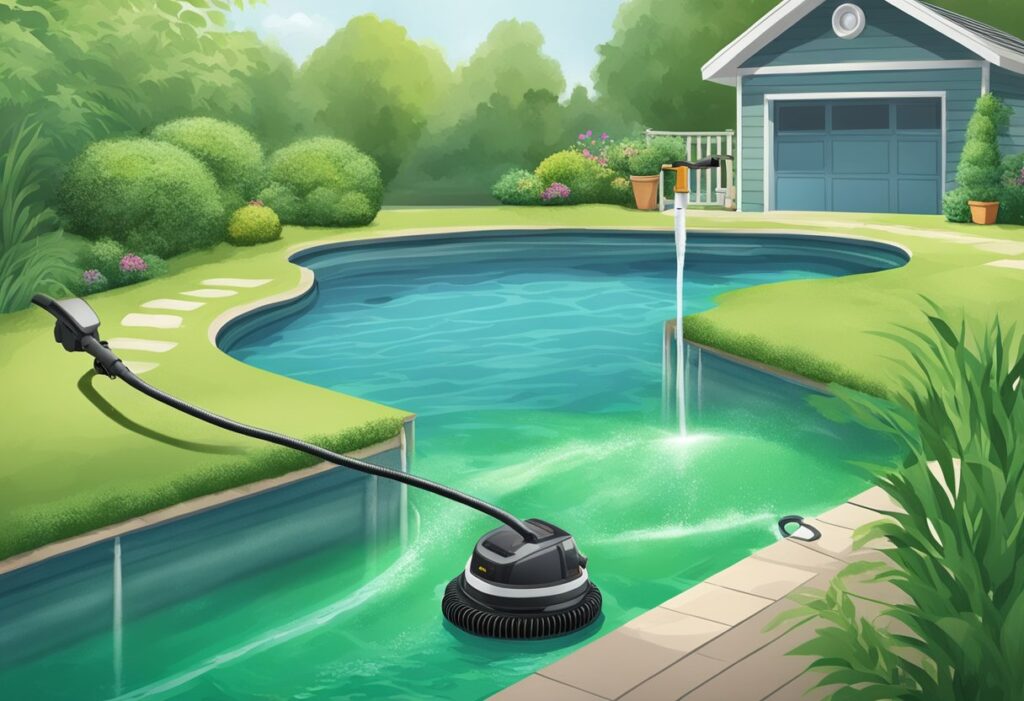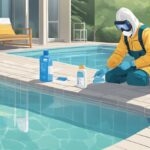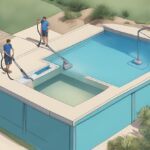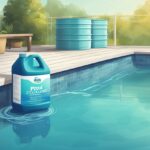Dealing with a green pool can be frustrating, but addressing the problem is both important for the safety of swimmers and the longevity of your pool. The green tint usually comes from algae that thrive in pools due to factors such as imbalanced chemicals, warm weather, and inadequate filtration. Restoring your pool to its pristine condition is quite straightforward once you know the steps to take.

Your first course of action is to test and adjust your pool’s pH levels; an optimal range is crucial for the effectiveness of chlorine, which is responsible for sanitising the water. Typically, you’d want a slightly acidic environment — a pH below 7.0 — to maximise the impact of chlorine and ensure that it works efficiently to kill the algae.
Once the pH level is adjusted, a substantial dose of chlorine, often referred to as ‘shock’, is required to kill the algae and clear the water. This super chlorination should be done carefully and, ideally, during the evening or at night, as UV light can diminish chlorine’s strength. Brushing the walls and floor of your pool will loosen the algae, allowing the chlorine to work more effectively. With consistent attention and proper treatment, your green pool can be clean and clear once again.
Understanding Your Pool’s Health
Maintaining a healthy pool is fundamental to your swimming experience and ensures the water is safe for use. Regular assessment of water chemistry and filtration efficiency is essential for clarity and hygiene.
Testing Water Chemistry
Testing the water chemistry of your pool is critical to maintain a balanced environment that is safe for swimmers. It’s vital to regularly check the following parameters:
- pH Level: This should be between 7.2 and 7.8. Higher or lower pH levels can lead to discomfort for swimmers and inefficient sanitiser performance.
- Total Alkalinity: Aim for a range of 80-120 ppm to stabilise pH levels.
- Available Chlorine and Total Chlorine: Ensure chlorine levels are between 1-3 ppm to effectively sanitise your pool without causing irritation.
- Calcium Hardness: Ideal levels should be between 200-400 ppm to prevent plaster damage.
- Chemical Levels: Regularly assess for stabiliser (cyanuric acid) levels to ensure chlorine is effective even in sunlight.
Utilise water testing kits or test strips for a straightforward way to measure these parameters. For a more thorough analysis, consider a professional water test.
Assessing Filtration System
Your pool’s filtration system is a frontline defence against impurities and helps maintain clear water:
- Pool Filter: Regularly check and clean your pool filters. A clogged or inefficient filter will impede water flow and sanitisation, leading to cloudy or green water.
- Filtration Time: Run your filter system for at least 8-10 hours each day to ensure proper water circulation and cleanliness.
Establish a routine check for the filtration system to prevent and quickly resolve issues that may cause your pool to turn green. Maintaining your pool’s health with consistent care is crucial for an enjoyable swimming experience.
Treating the Water
To effectively tackle a green pool, you need a strategic approach that enhances water quality and eliminates algae. The process involves balancing chemicals, executing a shock treatment, and taking preventive measures against further algae growth.
Balancing Chemicals
Before you attempt to clear the green water, it’s vital to test and adjust the chemical balance. This includes pH and alkalinity levels. For optimal results, your pool’s pH should be between 7.2 and 7.6, and the total alkalinity should range from 80 to 120 ppm (parts per million).
- pH Level: Add sodium bisulfate to lower pH or use soda ash to increase it.
- Alkalinity: To increase alkalinity, add sodium bicarbonate; to decrease it, use muriatic acid.
Shock Treatment
Once the chemical levels are balanced, it’s time for a shock treatment. This involves adding a large dose of chlorine, known as pool shock or chlorine shock, to the water to eradicate bacteria and algae.
- Dosage: Follow the instructions on your chlorine shock product carefully, ensuring you use the right amount for your pool’s volume.
- Circulation: Ensure your pool’s circulation system is running to distribute the chlorine evenly.
Preventing Algae Growth
After eliminating the algae, preventive measures are crucial to stop algae from recurring in your green swimming pool. These steps include:
- Sanitizer Levels: Maintain proper chlorine or sanitizer levels to continuously fight off bacteria and algae.
- Algaecides: Utilize algaecides as a proactive measure to inhibit algae growth.
Remember, consistent pool maintenance and monitoring of chemical levels are key to keeping your swimming pool clear and healthy.
Routine Maintenance and Cleaning
Effective pool maintenance and cleaning are essential for preventing algae growth and ensuring your pool remains a healthy environment for swimming. Regular brushing and vacuuming, along with diligent filter care, are foundational to maintaining clean and clear pool water.
Regular Brushing and Vacuuming
To prevent algae from taking hold on your pool walls and floor, make it a habit to thoroughly brush and vacuum your pool weekly. Use a pool brush attached to a telescopic pole to reach all areas, focusing on corners and steps where algae is prone to grow—these are often referred to as “dead spots.” For vacuuming, ensure you have a reliable pool vacuum that can remove debris efficiently.
- Brush pool walls and floor to remove algae and debris.
- Vacuum pool bottom and sides to extract settled particles.
Filter Care and Cleaning
Your pool’s filtration system is crucial for maintaining water clarity and hygiene. The filter should be inspected and cleaned regularly to ensure proper water circulation and filtration. There are different types of filters, such as sand, cartridge, and diatomaceous earth (DE), each requiring specific maintenance:
-
Sand Filters: Backwash the filter when the pressure gauge indicates a rise of about 8-10 psi above the normal operating level, usually every few weeks.
Activity Frequency Backwash As required based on pressure gauge Replace sand Every 5-7 years -
Cartridge Filters: Remove the cartridge and wash it with a hose. Replacement is usually needed every couple of years.
Activity Frequency Rinse off Bi-weekly or as needed Deep clean Annually Replace Every 2-3 years -
DE Filters: Backwash as with sand filters, and replenish the DE powder according to the manufacturer’s instructions.
Always follow the manufacturer’s guidelines for your specific filter type. As a preventive measure, check and clean your pump baskets and skimmer regularly to ensure optimal functioning of your pump and filter system. If your water is particularly troublesome, you might consider using a pool clarifier or flocculent to assist the filters in trapping tiny particles. Remember, consistent cleaning and proactive care of your filter will maintain your free chlorine level and water quality—the cornerstones of a clean pool.











